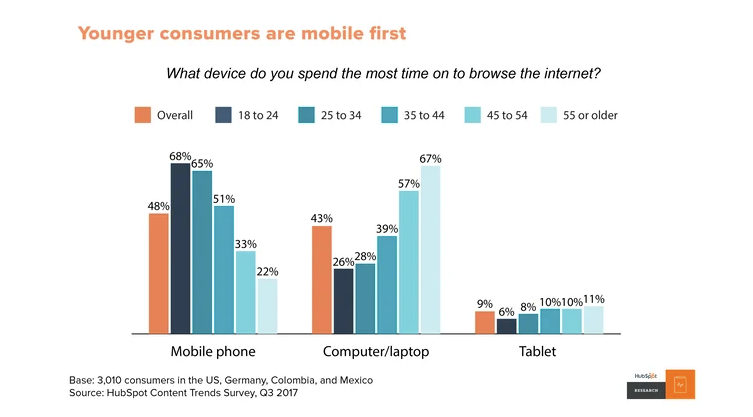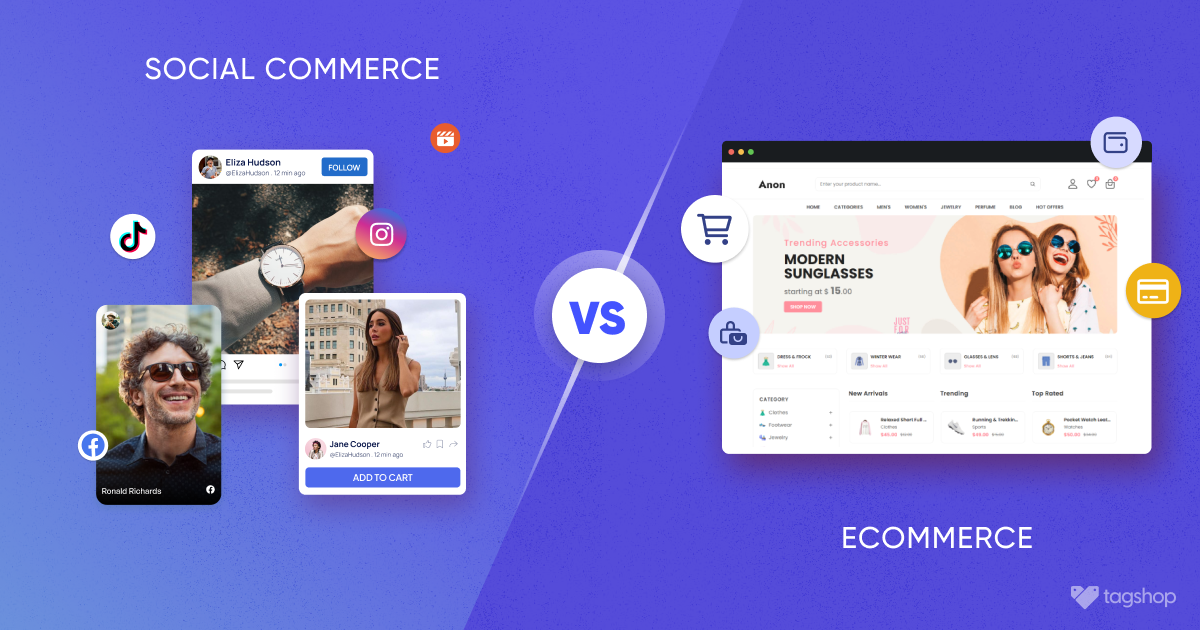Video Commerce: The Future of Ecommerce Businesses
You’re seriously missing out on a huge scope of growth if you’re not leveraging video commerce as an online business. The impact of social media has expanded tremendously over the years and has contributed to changing consumer behaviors, overall.
In fact, statistics suggest that e-commerce businesses using it for their marketing are improving 49% better revenue compared to businesses that are not.
However, what’s important to note is that it’s a strategy that takes effort to help businesses retrieve effective results and a fair return on investment.
In this article, we shall learn what is video commerce and how it adds value to e-commerce businesses.
What is Video Commerce?
Video commerce refers to the use of video content to promote and sell products. This type of commerce may include long-form or short-form video content, unboxing videos, product tutorials, or product showcasing videos.
It offers e-commerce businesses the ability to showcase their products in action and provide inspiration to customers.
That was for the definition of video commerce. Let’s quickly move ahead and learn how video e-commerce can add value to your e-commerce.
How Video Commerce Creates Value For E-Commerce?
Embracing video commerce as a strategic approach, when executed with perfection, holds the potential to deliver unparalleled results.
This strategy is invaluable and contributes significantly to e-commerce through various avenues. Here’s how:
1. Boosts Conversions & AOV
Statistics show that 87% of marketers believe video content can boost ROI. How? It’s simple. Video content captures more attention than various other forms of content. (textual and images) By incorporating shoppable video, e-commerce businesses can create an immersive shopping experience, keeping visitors on your site longer and increasing the likelihood of conversion.

Moreover, by showcasing multiple products in a video, brands can promote more products at once, providing shoppers with complete shop the look inspiration and improving the average order value.
2. Improves Product Visualization Significantly
Nowadays, online shopping is known for customer convenience. However, product showcasing remains a pain point for businesses.
Integrating video content allows customers to see products in action, providing a more comprehensive understanding of their features, functionalities, and real-life applications of your products and services. This visual depiction makes it easier for customers to make informed purchase decisions, leading to better customer satisfaction.
3. Contributes to Customer Acquisition
It is a compelling strategy that can help businesses display their offering on their e-commerce touchpoints with confidence.
Including videos on your product pages or in your content strategy allows your customers to see your products being actually used by existing customers. You can enhance your online visibility through UGC videos, product tutorials, and unboxing videos and acquire new customers easily.
4. Establishes Trust & Credibility
Unlike static imagery, video content is a more realistic way to showcase products. Seeing a product in action through video builds trust as customers get a closer look at what they are purchasing.
Video commerce creates great value for e-commerce brands, especially by collaborating with UGC creators, businesses can reduce uncertainty and increase customers’ confidence in the product’s quality and functionality.
Types of Video Commerce
There are primarily two types of video commerce that e-commerce brands can leverage to promote and sell their products.
| Live Video Commerce | Non-Live Video Commerce |
| Live video commerce refers to the type of commerce where brands host live shopping streams and showcase their products in real-time. | Non-live video commerce involves pre-recorded video content to showcase products. Customers can buy products through tagged products from the website. |
| Brands usually collaborate with influencers to host these live shopping streams for them on the brand’s website or social media. | E-commerce businesses can collaborate with influencers, utilize customer-generated content, or use branded content to display on the website. |
| Creates a sense of urgency and FOMO (fear of missing out) as viewers are part of a live event. | Non-live videos can be reused over time, providing value without the time constraints of live events. |
| Users can engage with the hosts in real-time, ask questions about the products, and make informed decisions. | Customers can take their time to check the product details, read reviews, and make confident purchasing decisions. |
| It gives a more realistic vision of the products, allowing customers to make decisions based on their first impressions of the product. | Brands can curate and edit videos for a polished and targeted demonstration of products or services. |
How Can E-commerce Brands Get Started With Video Commerce?
By now, you must know why e-commerce businesses must integrate it into their marketing strategy. Video e-commerce is a powerful force that can not only help brands display their products but also support businesses to ease the overall video shopping process of their users.
Here’s how e-commerce businesses can get started with video commerce:
1. Create content that benefits your brand
The foremost and most important step to getting started with commerce video is to create quality video content that sells. Statistically speaking, about 86% of businesses use video marketing today. It is easy to anticipate the quantity of video content on the internet.

To stand out from the competition, exploring types of video content and creating content that benefits your brand by collaborating with influencers and creators that suit your niche is essential.
2. Find out where your audience is
Even though most platforms out there, such as Instagram, TikTok, and Facebook, have become highly video-centric, not every platform can be suitable for your brand promotions. Each platform has a different range of audiences in terms of geolocation and age.
It is important to explore and find out where your audience is and host your promotional campaigns on the right platform.
3. Take support from efficient tools
Taking support from an efficient video commerce platform is also vital for e-commerce businesses that are just starting with this strategy. With the help of a video commerce platform, you can streamline the process of collecting and curating video content and integrating it into your website.
Additionally, you can also create a feed of shoppable videos by adding product tags to the content and allowing customers to shop from the content seamlessly.

4. Don’t forget mobile optimization
It is important to notice that at least 79% of smartphone users have purchased online using their mobile device in the last 6 months. Mobile commerce is a strategy that must be taken advantage of, especially by e-commerce businesses catering to younger consumers. The maximum number of mobile purchases are done by consumers between the ages of 18 to 34. This proves the importance of mobile optimization to leverage the full potential of your e-commerce business.
5. Track and analyze your content
When picking a shoppable video platform, make sure that it provides the ability to track and analyze data effectively. Use analytics tools provided by the platform to track the performance of your shoppable videos.
Monitor metrics such as views, engagement, click-through rates, and conversion rates. Analyzing this data will help you refine your strategy over time.
What Key Scenarios Does Video Commerce Serve?
It can be employed in various scenarios to serve different purposes and enhance the overall shopping experience. Here are key scenarios where it proves particularly effective:
1. Videos for Product Showcasing
Showcasing products in their most authentic light is one of the biggest challenges e-commerce businesses face. With in-depth product demonstration videos in the scenario, brands can highlight the key features, design, and functionality of their products. These videos provide a visual and dynamic representation, giving potential customers a closer look at what they are considering purchasing.

2. Product Tutorial Videos
It also helps businesses to guide customers on how to use a product effectively. This is especially valuable for e-commerce brands dealing in electronics or complex products with multiple features. Customers appreciate having a visual guide that walks them through the steps, enhancing their understanding and ensuring a positive user experience. Moreover, consider doing a live stream through video transcoding while guiding your customers and interacting with them in real time, answering questions, and building stronger connections.
3. Visual Reviews
Visual reviews go beyond written testimonials by allowing customers to share their experiences through video. Seeing real customers using and talking about the product adds authenticity and credibility. This type of user-generated content can influence potential buyers and build trust in the brand.
4. Promotional Videos
Promotional videos are crafted to highlight special offers, discounts, or limited-time promotions. They create a sense of urgency and excitement, encouraging viewers to take advantage of the deal. Shoppable elements in these videos allow customers to act on the promotion, boosting conversion rates quickly.
Conclusions
Video commerce is an immensely powerful strategy for modern e-commerce businesses looking to harness their tough-earned social content to increase sales. As stated, the engagement video content brings is incomparable and can significantly contribute to building an active customer base.
The only loophole is the effective use of this strategy. By incorporating a measured strategy, brands can not only triple their numbers but also bring a more engaged audience to their door.
Frequently Asked Questions
How does video commerce differ from traditional e-commerce?
While traditional commerce involves branded content and pre-shot content to sell and promote products, video commerce incorporates authentic video content to allow consumers to make purchases.
What are the key benefits of incorporating video commerce into an online business strategy?
By incorporating video commerce, e-commerce businesses can provide an immersive shopping experience for customers, improve their website’s dwell time, increase the average order value, and establish trust and credibility for their brand.
Are there any tools or platforms specifically designed for video commerce?
Tagshop is one of the highest-rated video commerce platforms making it possible for e-commerce businesses to collect seamlessly video content and curate it in captivating shoppable galleries. With the help of Tagshop, businesses can incorporate these galleries into their preferred e-commerce touchpoints like homepages, PDPs, and emails.
How can video commerce enhance customer trust and confidence?
By providing authentic video reviews, product demonstrations, and other forms of genuine content to customers, businesses can establish customer trust and boost confidence in their business.
How can live video be used in video commerce?
E-commerce businesses can use live video commerce to host live shopping streams, allowing customers to make their purchases in real time. Moreover, businesses can collaborate with influencers to host live streams for them on their social media for better engagement and visibility.
What are some benefits of using customer-generated video content in video commerce?
Customer-generated content is the most powerful source to build trust and confidence in potential customers. Businesses can boost their sales and revenue by showcasing the genuine experiences of existing or past customers at relevant places.






